The Desktop Kabini Review Part 1: AMD Athlon 5350 (AM1) Tested
by Ian Cutress on April 9, 2014 8:00 AM ESTCPU Benchmarks
Console Emulation – Dolphin Benchmark: link
At the start of 2014 I was emailed with a link to a new emulation benchmark based on the Dolphin Emulator. The issue with emulators tends to be two-fold: game licensing and raw CPU power required for the emulation. As a result, many emulators are often bound by single thread CPU performance, and general reports tended to suggest that Haswell provided a significant post to emulator performance. This benchmark runs a Wii program that raytraces a complex 3D scene inside the Dolphin Wii emulator. Performance on this benchmark is a good proxy of the speed of Dolphin CPU emulation, which is an intensive single core task using most aspects of a CPU. Results are given in minutes, where the Wii itself scores 17.53; meaning that anything above this is faster than an actual Wii for processing Wii code, albeit emulated.
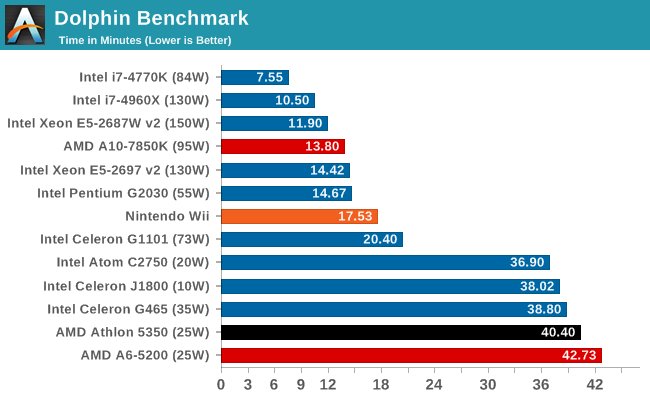
Point Calculations – 3D Movement Algorithm Test: link
3DPM is a self-penned benchmark, taking basic 3D movement algorithms used in Brownian Motion simulations and testing them for speed. High floating point performance, MHz and IPC wins in the single thread version, whereas the multithread version has to handle the threads and loves more cores.
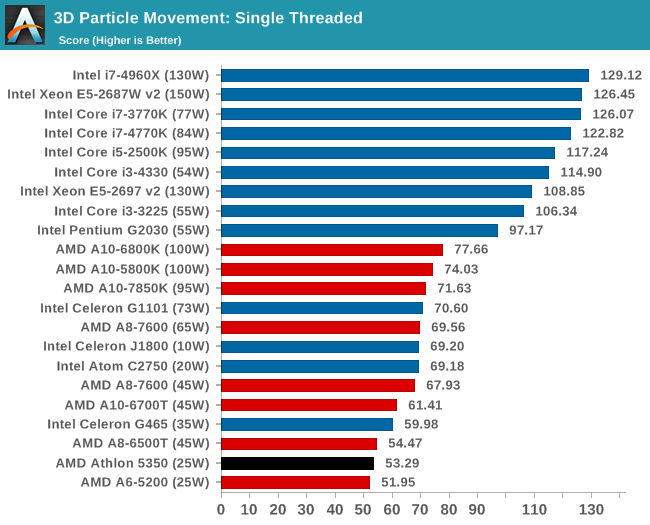
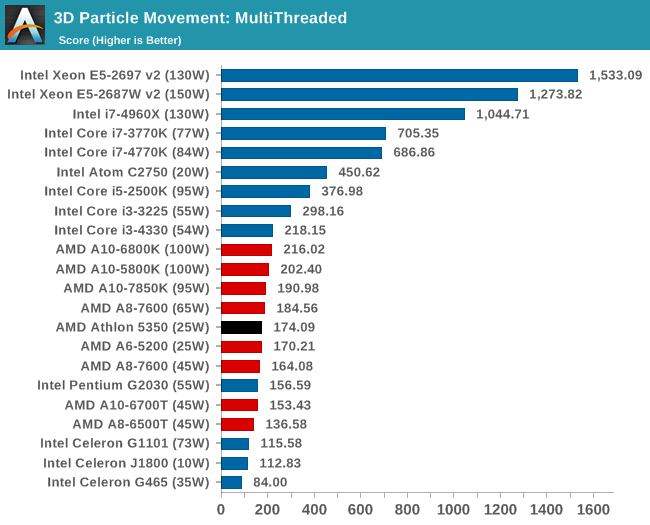
Encryption –TrueCrypt v0.7.1a: link
TrueCrypt is an off the shelf open source encryption tool for files and folders. For our test we run the benchmark mode using a 1GB buffer and take the mean result from AES encryption.
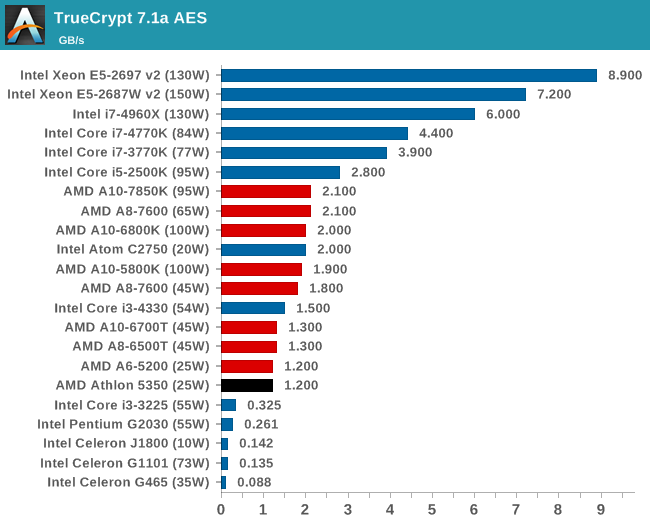
Synthetic – 7-Zip 9.2: link
As an open source compression tool, 7-Zip is a popular tool for making sets of files easier to handle and transfer. The software offers up its own benchmark, to which we report the result.
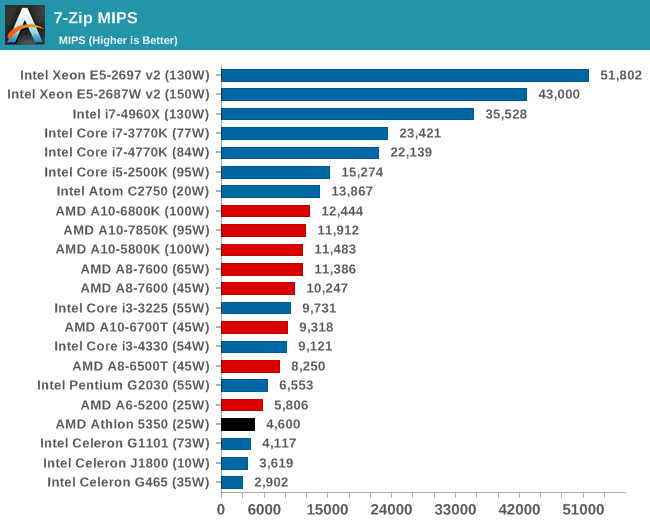
Rendering – PovRay 3.7: link
The Persistence of Vision RayTracer, or PovRay, is a freeware package for as the name suggests, ray tracing. It is a pure renderer, rather than modeling software, but the latest beta version contains a handy benchmark for stressing all processing threads on a platform. We have been using this test in motherboard reviews to test memory stability at various CPU speeds to good effect – if it passes the test, the IMC in the CPU is stable for a given CPU speed. As a CPU test, it runs for approximately 2-3 minutes on high end platforms.
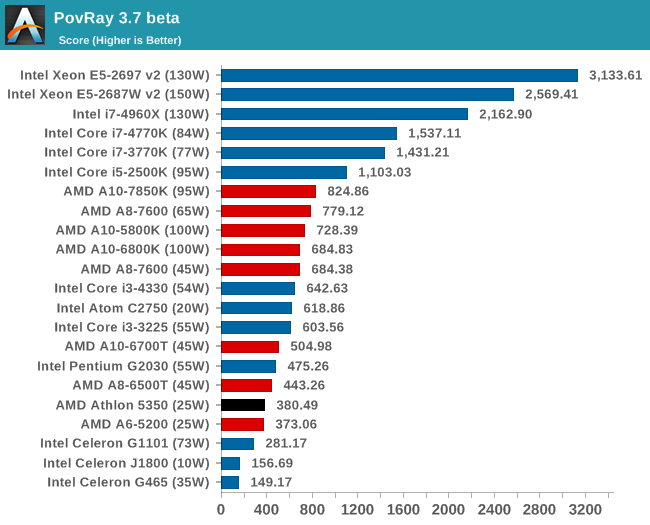










126 Comments
View All Comments
ozzuneoj86 - Wednesday, April 9, 2014 - link
I do hope that all of this works out for AMD. It seems like a pretty huge gamble to invest so much time and energy into creating a new socketed platform. I do like the idea of tiny yet powerful systems, for sure. I built a Pentium 4 based mini-ITX system that won Maximum PC's rig of the month in July 2007, since there were relatively few ITX systems available at the time. This was pre-Atom, so you were either spending $300+ on a board that took an equally expensive Core-based laptop CPU, or you were going with a Via C7 or some other abysmally slow chip built into a board that still cost $200. Our grand total for the whole project was under $500.That system is socketed, but with Intel Extreme 2 graphics (before GMA) and only a PCI slot to work with, there was only so much it could be used for. It handles emulators perfectly fine though.
Anyway, I just hope they hang on to this platform for a while so that it makes sense for it to be socketed. Looking at the CPU options available, it doesn't look like it offers a huge range of possibilities. They are all quite firmly seated in the low end of performance and aren't all that power efficient. I could see a low end platform being useful if they offered significantly different combinations of CPU power, GPU power and wattages, but I'm not really seeing that with these.
ozzuneoj86 - Wednesday, April 9, 2014 - link
For clarification, by "not all that power efficient" I mean the TDP, when compared to Intel's non-socketed chips. These are still fairly low wattage, but you can't exactly stuff one of these in a cigar box and run in passively cooled.Also, any chance we could get a Celeron 1037u system benchmarked as well? I'm curious as to how the CPU\GPU performance compares to the J series, as well as Kabini. http://ark.intel.com/products/71995
Hardened - Thursday, April 10, 2014 - link
I woul like to support request for comparison with Celeron 1037U. It is a very interesting CPU performance and cost wise. Gigabyte GA-1037UN mobo is also a very nice offer with 2x LAN and eSATA ports all under 90 USD.Computer Bottleneck - Wednesday, April 9, 2014 - link
Do we know if any manufacturers will be supporting ECC RAM on these boards? Or any upcoming AM1 boards?According to CPU World Athlon 5350 does indeed support ECC:
http://www.cpu-world.com/CPUs/Jaguar/AMD-Athlon%20...
TheCrustyCupcake - Wednesday, April 9, 2014 - link
Water cooled AM1 socket-ed APU's anyone? If overclocking was available I could see an EVGA super ultra FTW edition AM1 motherboard with an 8-pin supplemental CPU power connector, and crossfire support!DudemanX - Wednesday, April 9, 2014 - link
In part 2 and in future articles when reviewing IGPs, can you do some game benchmarks at more mainstream resolutions(1680, 1920, maybe even 1440) but with "Low" quality settings? Many might disagree but not running my display at native resolution is one of the last compromises I make when using inadequate hardware. I understand these aren't mainstream chips but they are desktop/media center chips. Do people really buy desktop monitors/TVs lower than 1680 these days? Certainly no one's running games in 4:3 anymore, are they?mariush - Wednesday, April 9, 2014 - link
I just don't understand why they don't make the boards for these systems to run on 12-19v laptop adapter type power supplies.It's really not that expensive to add a dc-dc converter on the motherboard to make 5v for the sata drives and onboard stuff... no, we still have to use a big fat 24pin atx cable AND a 4 pin cpu cable for a system that uses 30-60 watts (without a powerful video card).
srkelley - Wednesday, April 9, 2014 - link
Can you post some modified benchmarks of the gaming performance please? I'm interested in seeing the average frame rate of the same games but run with Medium settings at 1280x720 please. It doesn't need to be in a fancy chart or done completely scientifically, just a few numbers would be helpful!shady28 - Thursday, April 10, 2014 - link
Great review, this helps clear up some questions regarding AM1.Suggestion for your follow up -
If possible, show more of the chips this succeeds and that it competes against.
ie :
J1800, J1900, 3770, and some of the older Atoms like D525 or D510.
It would also be interesting to see a couple of older reference desktop, like a P4 D chip. For some this would help answer the question, is this a viable upgrade for someone who wants a small low power replacement for an old power hog of a P4?
The obligatory i5-2500k or i5-3570k is fine, but stacking up a huge number of 100W chips in the comparison doesn't help, it just clutters up the charts with products that in no way compete with something like Kabini.
Penti - Thursday, April 10, 2014 - link
So it's a Kabini/Jaguar fabbed at Global Foundries in Germany? Why?